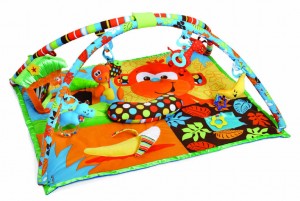 As soon as your new baby gets home from the hospital or birthing center, it’s time to hit the gym–as in the activity gym–for some tummy time, a.k.a your baby’s version of push-ups.
As soon as your new baby gets home from the hospital or birthing center, it’s time to hit the gym–as in the activity gym–for some tummy time, a.k.a your baby’s version of push-ups.
Why is tummy time so important?
After American Academy of Pediatrics started the “Back to Sleep” campaign in 1994, SIDS rates have declined by over 50 percent. The not-so-great news? Because babies spend so much time on their backs these days when they’re sleeping, they may not be spending enough time on their tummies when they’re awake. A tummy time deficit may affect your baby’s development. Here’s why:
When babies spend time on their tummies during play time, they use their shoulder muscles to push their head and shoulders off the floor. “Tummy time increases head and neck control and body strength and improves balance,” says pediatrician Brannon Perilloux, M.D.
Without adequate time on their tummies, however, babies may experience deficits, including weak neck and shoulder muscles, which can delay a baby’s ability to roll over, sit up without support, crawl and pull to standing.
Down the road…tummy-time-deprived toddlers can end up with wimpy neck, shoulder and jaw muscles that can impact their ability to hit other developmental milestones.
Consider: “Adequate neck control can impact a baby’s eating and speech development,” says Melanie Mintz, DPT, a board-certified pediatric physical therapist, because the same muscles that babies use to hold their head up also support their jaws.
When babies push themselves up through their hands when they’re on their tummies, they develop the shoulder support that can impact the fine motor skills they’ll eventually need to learn to eat, hold a crayon and dress themselves.
Moreover, the muscle tone babies develop from tummy time helps them feel more in control of their surroundings, which has global repercussions. The more relaxed babies are with their environment, the more they can attend to visual and auditory stimuli going on around them, which helps develop language.
Tummy time can also help prevent plagiocephaly (flat-head syndrome) and torticollis (weak neck muscles on one side), both of which have increased in babies since the back-to-sleep campaign began.
When should tummy time start?
“Tummy time should start from day one,” Mintz says. Start with 3 to 5 minutes, two to three times each day as soon as you’re get home from the hospital or birthing center.
If your newborn has been missing out on tummy time sessions so far, it’s not too late to start. Gradually up the ante and add increments of tummy time, such as 15 minutes, four times a day.
How much tummy time does your baby need?
“As your baby gets older, 30 to 90 minutes total per day is optimal,” says Mintz.
Feel free to break that time up into five or 10-minute spurts, or however long your baby can take it. You can officially call it quits to tummy time altogether when your baby starts to roll and crawl.
In the meantime, here’s how to make the most of this underrated developmental activity.
Tummy time to-do tactics
Be your baby’s first play mat
For the youngest babies who cry when they’re placed on the floor or for babies with reflux, try an inclined version of tummy time: Have your baby lie on your chest, while you sit in a semi-reclined position. An incline is easier on babies because they don’t have to use as much muscle strength to hold their head up. Most babies enjoy the skin to skin contact too.
Talk to your baby while you’re at it, or sing songs or tell him a story, anything that engages your baby and makes eye contact, which helps foster cognitive, social and emotional development. Ease your baby into it. “Work your way down to a reclined position,” Mintz says.
Graduate to an activity gym
A take-off on the mobile, activity gyms feature brightly-colored floor and hanging detachable toys that make sounds, play music and offer interesting textures. Some activity gym toys may include unbreakable, embedded mirrors, a definite plus.
Babies love to look at their own image. Activity gyms help babies explore their environment through their sense of sound, touch, sight and taste. Their fine motor skills also get a tune-up when they bat, reach and grab for toys.

Another tummy time option for babies 3 months+ beyond the activity gym: The Infantino pat & play water mat. Just fill with water and watch your baby reach for the six floating sea pals. It’s the perfect tummy time toy for your baby’s sensory development.
What if my baby hates tummy time?

If your baby fusses during tummy time on a play mat, distract him with the gym’s lights, music and crinkle toys until he gets used to it. Also, take turns with your baby making the activity gym’s elephant ear crinkle, for example, and engage with other toys.
When your baby is around 4 months old, detach her favorite toys and place them just out of her reach in a circle during tummy time, either lying down or supported by you or a Boppy.
At first, your baby might just gesture in direction toward the object. Eventually, she’ll be able to reach out and pull objects forward, which is looks like such a small thing. But it’s big. “One of the precursors to crawling is being able to shift your weight and pivot on your tummy,” Mintz says.
Stay grounded
To make the most of tummy time and make even more fun for your baby, try these tricks:
- Get down on the floor with your baby and shake a rattle or keys at various points of your baby’s sight so he’ll enjoy the surprise of hearing the toy’s sound from different angles.
- Have your baby grab for toys with either hand to help develop both sides of her brain; sometimes present toys on her right side, sometimes on her left. (FYI: Your baby won’t show true hand dominance until age 2.)
- Try tracking: hold a toy six to 12 inches from your baby’s face, which is where babies 4 months and under see it best, with your baby lying down, and move it back and forth slowly. This technique helps develop eye coordination and vision.
- In time, take turns playing with a toy to help establish the notion of turn taking, an important lesson for kids of all ages.
Warning: Your baby might find the arcade that is her activity
gym so entertaining, you’ll be tempted to park her there while you finally get some stuff done around the house. But for safety and other reasons, it’s best to hang out in the same room as your baby. You want to make sure your baby doesn’t end up with her face smooshed into the floor.
And besides, your baby learns best by interacting with you and other caregivers. When you choose activities like tummy time, you’re helping your baby foster motor, cognitive and social skills he/she can build on. You’re a key player in the process, so don’t give the activity gym all the credit. Babies crave the one-on-one social interaction and the security tummy time provides.






With your post, your readers, particularly those beginners who are trying to explore this field won’t leave your page empty-handed. Here is mine at QN9 I am sure you’ll gain some useful information about Airport Transfer too.